|
Eclipse Revelations
Did Planet X, aka Nibiru make an appearance during the eclipse
on March 20, 2015? It did indeed, or at least the Moon Swirls
were evident. As is typical during eclipse viewing, official
viewing sites reduce the glare of the Sun so much that the sky
appears black, rather than light blue. Thus any evidence of
Planet X is lost in the dark. Khartoum
and India caught
a partial eclipse. The
UK had an 83% eclipse but cloudy skies. And Svalbard in
Norway had the best view due not only to being in the right
swath but also due to having clear skies.

- 'Breathtaking' Solar Eclipse Witnessed
by Millions
March 20, 2015
http://www.bbc.com/news/science-environment-31965456
- A great swathe of the Earth's
surface was plunged into darkness as the Moon came between
us and the Sun. In all parts of the UK, the eclipse
reached at least 83%, with the darkness peaking at about
09:35 GMT. The precise timing and degree of the eclipse
varied with location.
A video from the Telegraph
in the UK showed a dark orb at the 4 o’clock position to the
Sun, but this is likely a Moon Swirl rather than the corpus of
Planet X itself. This Moon Swirl shows up in images from
Svalbard, Norway also. Note that in the Telegraph video, the
dark orb, at times with a companion, drifts away from the Sun,
drifting to the right. The Sun is moving left to right as it
rises at this time of day, so if this dark spot were a smudge on
the lens, logically the Sun should have moved over the dark
orb.

Footage from
Svalbard, where there was a total eclipse, showed blurping
about on the Sun’s surface, arcs and the glow from solar
activity, as expected. But there were also
anomalies. An orb, standing out from the surface of the Sun, was
clearly captured at the 10 o’clock position. This correlates
with the location shown on Alberto’s photos where the tail of
Planet X lands as it wafts below the Sun to the left, then up.

The Moon Swirls made an appearance not
where solar activity was located, but where the Sun was quiet. Solar
Prominences can be seen along the edge of the Sun, aligned
with solar activity, as these images of the Sun taken during the
time of the eclipse show. The ecliptic was also straight
across in the view from the UK and Svalbard, so a tilted
ecliptic did not skew the view.

Germanwings Crash
Yet another airplane crashes due to electro-magnetic pulse.
This time the crash was in the heart of Europe in the foothills
of the Alps. The Zetas explain that stretch zones are
susceptible to attracting the charged tail of Planet X, and the
Eurasian Plate is under a stretch.
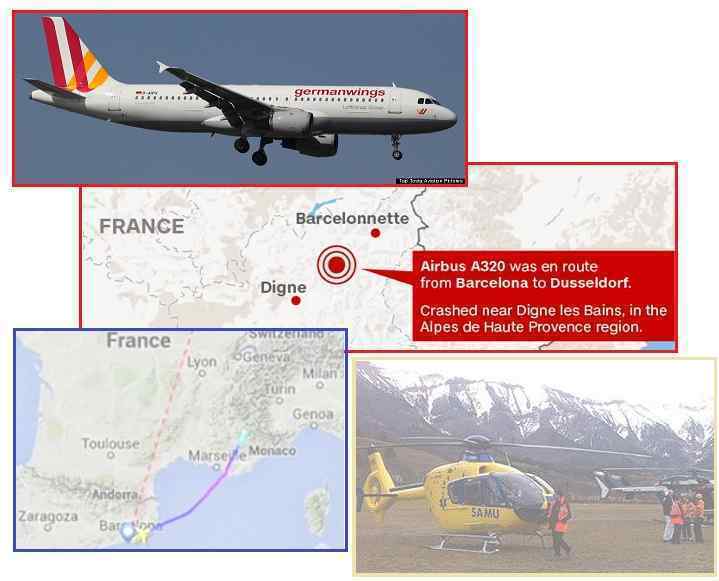
- Germanwings Crash: Plane Obliterated,
150 Presumed Dead
March 24, 2015
http://www.cnn.com/2015/03/24/europe/france-plane-crash/index.html
- March 24, 2015. A Germanwings
Airbus A320 plane carrying at least 148 people crashed
Tuesday in the foothills of the Alps in southeastern
France. The plane crashed near Digne-les-Bains, in the
Alpes de Haute Provence region.
- Germanwings Plane Crashes In South
France, 150 Feared Dead
March 24, 2015
http://www.huffingtonpost.com/2015/03/24/germanwings-plane-crash
- The cause of the crash was not
immediately clear. There did not appear to be turbulence
or low cloud ceiling in the area.
ZetaTalk Summary
3/28/2015: We
have repeatedly stressed that certain parts of the globe are
susceptible to interaction with the charged tail of Planet X.
This is certainly the case on the Sunda Plate, which is under
continuous pressure to slip under the curve of the
Indo-Australian Plate, as the MH 370 disaster
shows. Stretch zones are most susceptible to the
electromagnetic screech in the rock and the interplay with the
charged tail of Planet X that causes interference with
airplane electronics. This can be seen by AF 447 in 2009 while
over the spreading Atlantic Rift. All of the Eurasian
Plate, from the UK through to China, is under such a stretch.
This can be seen in the hum in the UK
and disappearing
radar over the Danube
River course and methane
flashes in the Urals and
the Sleepy
Hollow phenomena.
What was the cause of the Germanwings crash? What is known is
that the plane reached cruising speed and then began a descent.
Meanwhile there was no communication from the cockpit, though
communication lines had been open just a minute before the
descent. If there was total electronic failure, as happened for
AF 447 in 2009 and MH 370 in 2014, with no oxygen pumped into
the cockpit or passenger cabin, the pilot can become
unconscious.
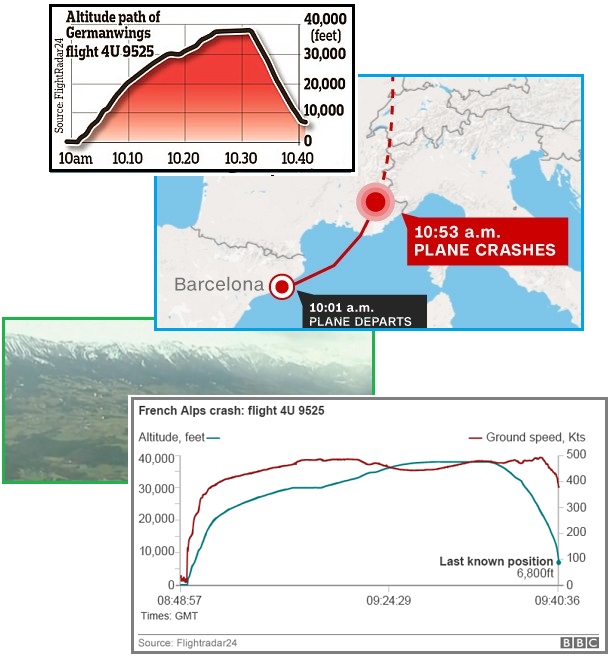
- Airbus A320 Plane Crash in Southern
France
March 24, 2015
http://rt.com/news/243533-plane-crash-german-wings/
- Germanwings say they are not aware
of any complications during the descent of the aircraft.
It started descending one minute after reaching its
cruising height and continued to lose altitude for eight
minutes, before finally crashing. Air traffic controllers
said they were in contact with the pilots of the
Germanwings A320 aircraft just a minute before the plane
started to descend.
- Britons on Board Doomed Germanwings
Flight 4U 9525
March 25, 2015
http://www.dailymail.co.uk/news/article-3009151/headlines-news-Germanwings
- Air traffic controllers claimed
they received no SOS despite the jet nosediving 32,000 ft
in just eight minutes. It is understood to have crashed at
more than 400mph.
Without oxygen, the pilots and crew as well as the passengers
will quickly become sleepy, confused, nauseous, and unconscious.
If brain death occurs within four minutes, the stage where one
is confused and unconscious occurs very quickly, in less than a
minute. Electromagnetic pulse also affects electronics
selectively, some incapacitated, some only damaged, but other
managing to function. Electromagnetic pulse also makes one
sleepy, as the Sleepy Hollow phenomena shows.
- Cerebral Hypoxia
http://en.wikipedia.org/wiki/Cerebral_hypoxia
- Continued oxygen deprivation
results in fainting, long-term loss of consciousness,
coma, seizures, cessation of brain stem reflexes, and
brain death.
- Asphyxia
http://encyclopedia2.thefreedictionary.com/Oxygen+deprivation
- Symptoms of asphyxia vary but may
include light-headedness, nausea, and gasping, followed by
unconsciousness and death. An area quickly affected is the
cerebral cortex, the brain center for speech and other
conscious behavior; it can be irreparably damaged by as
little as five minutes of oxygen deprivation.
- Electromagnetic Pulse
http://midimagic.sgc-hosting.com/emp.htm
- The electromagnetic pulse induces
large currents in conductors that are part of or are
connected to the equipment. These high currents can do the
following: Induce voltages high enough to arc from
one conductor to another, damaging whatever is connected
to them. Induce voltages high enough to arc from a
conductor to a device, damaging the device. Exceed the
current-carrying capabilities of conductors or components
in the device, damaging them. Induce voltages that exceed
the voltage limitations of components in the device,
damaging them. Induce voltages that exceed the breakdown
voltage of insulation in the device, damaging other
components. Cause voltage spikes that move atoms around in
the doping of semiconductors, ruining them. Cause voltage
spikes that puncture through the metallic oxide gates in
semiconductors, ruining them. Cause all of the sparkplugs
in an internal combustion engine to fire at the same time,
stopping the engine. Damage the semiconductors in an
electronic ignition system, stopping the engine and
keeping it from running again. Blow fuses in electric
power transmission lines, putting them out of service
until the fuses are replaced.
One of the flight data recorders, the voice recorder from the
cockpit, was retrieved and revealed that up until the descent
all was normal and calm. Then when they reached cruising
altitude the pilot left the cockpit and went to the bathroom but
could not get back in. In the limited
audio released to the media, the pilot can be heard pounding on
the door. However, A320 doors are electronically
controlled, locking and unlocking electronically. Loss of
electronic control would have locked
the door and disabled the pad. Or there would have been frantic
keypad buzzing, clicking of the toggle switch in the cockpit to
re-lock the door, and intercom phone calls. None
of this was mentioned by the media. Why not?
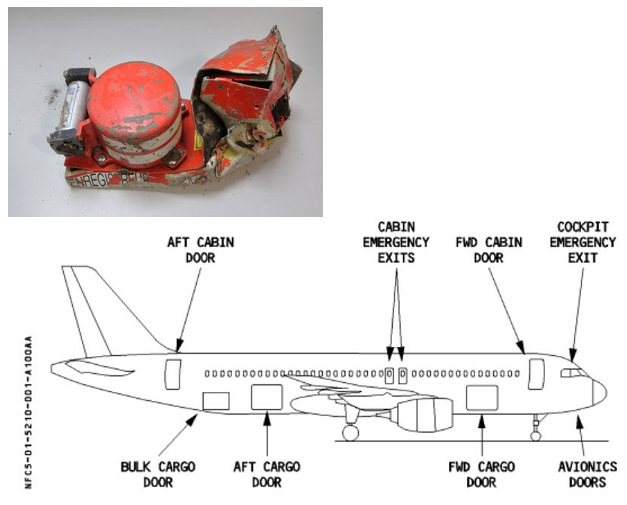
- A320 Doors
http://www.smartcockpit.com/aircraft-ressources/A320-Doors.html
- Cockpit Door: A forward-opening
door separates the cockpit from the passenger compartment.
In an emergency it can be forced open in either direction.
The door has an electric locking latch controlled by the
door unlock pushbutton on the pedestal. To unlock the
door, the pilot must press the pushbutton, and maintain it
pressed.
- Germanwings Pilot Was Locked Out
of Cockpit Before Crash in France
March 26, 2015
http://www.nytimes.com/2015/03/26/world/europe/germanwings-airbus-crash
- The audio indicated that one of
the pilots left the cockpit and could not re-enter. “The
guy outside is knocking lightly on the door, and there is
no answer,” the investigator said. “And then he hits the
door stronger, and no answer. There is never an answer.”
He said, “You can hear he is trying to smash the door
down.” Among the theories that have been put forward
by air safety analysts not involved in the investigation
is the possibility that a pilot could have been
incapacitated by a sudden event such as a fire or a drop
in cabin pressure.
- Germanwing Crash Not the Full Story
March 29, 2015
http://www.sott.net/article/294482-Germanwings-crash-Not-the-full-story
- Arnoux also wonders why no mention
was made by investigators of hearing the loud strident
beeping made by the cockpit door console when the
emergency access code is entered to open the cockpit door.
Arnoux recognizes that the emergency unlock code could
have been overridden by someone in the cockpit manually
holding the lock button down, but this would not have
prevented the beeping once the code was entered outside.
This would have been the clearest confirmation that one of
the pilots had been locked out. Yet no mention was made of
it.
The press is claiming the sounds of the co-pilot breathing
steadily can be heard, thus his intention to commit suicide.
This is more symptomatic of an unconscious co-pilot, as someone
deliberately flying into a mountainside would be emotional and
breathing rapidly. An unconscious co-pilot could also have
fallen sideways onto the joystick, pushing it forward to cause
the descent. The media only
mentions turning a dial to control descent, which is an
adjustment to the autopilot, not the joystick option.
Manipulating the joystick overrides the autopilot. Why not?
Because for airline profits to be maintained, the co-pilot is
being blamed.
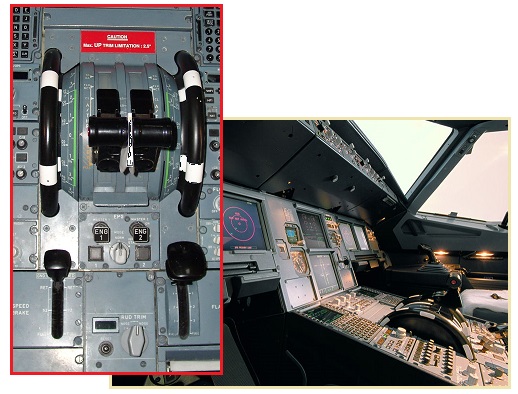
- The A320 is the First Launched
Engineering Essay
http://www.ukessays.com/essays/engineering/the-a320-is-the-first-launched-engineering-essay
- The A320 families typically used
digital fly-by-wire control systems and control the
aircraft by joystick at side-stick usually on right hand
side, in commercial aircraft.
- Avcanada Forum
March 25, 2015
http://www.avcanada.ca/forums2/viewtopic.php?f=118&t=102237&start=25
- I have a question specifically for
Airbus drivers. In normal cruise configuration, should a
pilot end up leaning on the sidestick, pushing it forward,
what will the aircraft do? Thinking about a possible
incapacitation scenario, ie slumped forward due to a heart
attack or anurism or some such event. What would the
aircraft do with normal cruise set on auto, but a
sidestick pushed forward?
ZetaTalk Analysis
3/28/2015: Has
the public been allowed to hear the cockpit voice recorder?
This will not be allowed, or only after it has been altered to
fit the circumstances. What is missing at present is the door
access buzzer. Normal exit and entry are via an intercom
identification after a single keypad button is pushed. In an
emergency a code can be typed into the keypad. It is true that
the cockpit can block entry by pressing the lock button
continuously. But during all or any of this, a buzzer is
loudly sounding. If scraping chairs and a shutting door and
steady breathing can be heard, where is the buzzer? The
press has made much of the co-pilot breathing “steadily”,
proof that he is alive and the crash deliberate. Anyone
conscious and seeing a crash into a mountain side looming will
not be calm. This is an involuntary response. He would be
screaming, and rapidly breathing. Oxygen deprivation first
involves confusion and sleepiness, then becoming unconscious,
so unless alerted that the oxygen level is dropping, the
co-pilot was unaware this was happening to him. How often do
carbon monoxide deaths occur where the family is taken
unaware?
Compare the sounds of the last
60 seconds recorded on the Germanwings cockpit recorder to
the sounds
expected from an A 320 cockpit. Note that only the last 60
second were released to the media. Bild, a German magazine, also
released the full transcript of the
audio, which matches reports to date and the 60 second audio
released to the media. If the electronic operation of the door
were involved at any time, the intercom
phone ringing would be heard. If this resulted in the
co-pilot unlocking the door, or trying to push the toggle to
lock so it could not
be unlocked, the sound of the toggle
would be heard as well as the keypad
buzzer in the cockpit. If the co-pilot was ignoring
these requests, then repeated keypad buzzing and toggle to lock
would be heard, yet none of this was reported in the media. If,
per the narrative being pushed in the media, the co-pilot had
thrown a bolt on the door, then this
too would be heard on the tape, as the media is
claiming that a chair scuff on the floor and the sound of a
shutting door could be heard. And in any case, the keypad would
be tried, at least at first. The last 60 seconds include only pounding on the door with voices in
the background, an alarm a few
seconds before impact, more voices in
the background and at the very end yet another alarm
or call. None of the sounds on the recording match the
anticipated intercom or keypad sounds.
So what caused the crash? The African Roll may have only just
started, but there are signs that the Mediterranean is pulling
apart while the African Plate drops. This stretch does indeed
affect the foothills of the Alps.

ZetaTalk Comment
3/28/2015: Recently
passengers on a flight from Barcelona to Israel
grew faint from methane gas brought into the plane as it
traveled along the spreading Mediterranean rip. Barcelona was
in the news again when an EasyJet was struck by lightning.
We have predicted that the African Roll will pull Gibraltar
apart by an additional 125 miles. The Mediterranean in the
past was a swamp, but now is a sea, due to such actions in the
past. When the edge of the Eurasian Plate loses support along
the Mediterranean, what does this do to the rock in the area?
Rock being pulled apart does
not just register distress at the rip point. Rock layers are
attached, glued to other rock layers and to seams within the
rock layers themselves for long distances. The Germanwings
A320 was rising above the Alps, at the very foothills where in
the past the rock had been jammed under the high Alps. The
foothills of the Alps present a complicated situation, where
rock layers below the Alps are subject to the long reach of
the stretching of the Mediterranean, while the weight of the
Alps prevents these pulled rock layers from being able to
adjust. It is thus an aggravated stretch zone, and thus
dangerous for air travel.
CERN also had magnetic problems, just two days before
and in the days after
the Germanwings airplane crashed. CERN uses magnets intensively,
and thus would be subject to the electromagnetic pulse that
disabled the Germanwings plane in the French Alps. CERN is
located in Geneva, nearby, also on the Franco-Swiss border.
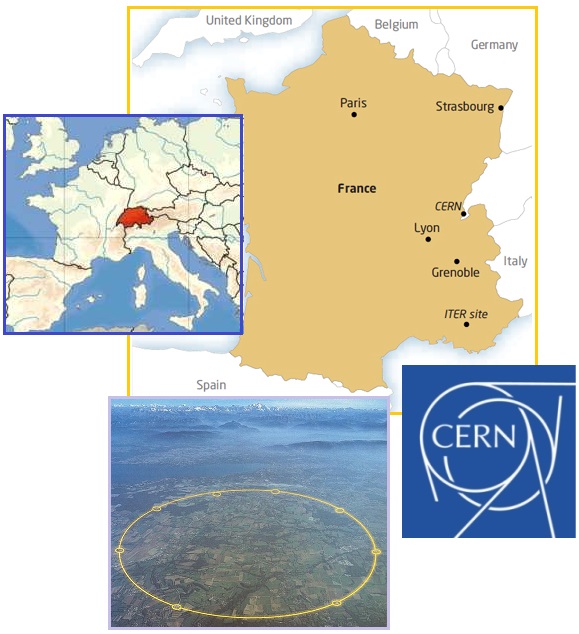
- In pictures: X-rays Probe LHC for
Cause of Short Circuit
March 26, 2015
http://home.web.cern.ch/about/updates/2015/03/pictures-x-rays-probe-lhc-cause-short-circuit
- Early last Saturday morning [March
21], while full-scale tests of all systems were ongoing in
preparation for beam injection, an earth fault developed
in the main dipole circuit of sector 3-4 of the Large
Hadron Collider (LHC). All the protection systems
worked properly and there was no harm done. The fault
developed at relatively low current and was initially
intermittent in nature.
- Electric Fault Delays Relaunch of CERN
Collider after Two-Year Refit
March 25, 2015
http://in.mobile.reuters.com/article/idINKBN0MK2EY20150324?irpc=932
- Engineers had been expected to
start on Wednesday [March 25] pumping proton beams in
opposite directions all the way round the two 27-km
(17-mile) underground tubes in the LHC, closed down for
the past two years for a refit. Scientists at Europe's
CERN research centre have had to postpone the imminent
relaunch of their refitted 'Big Bang' machine, the Large
Hadron Collider, because of a short-circuit in the wiring
of one of the vital magnets.
In the days following the crash of the Germanwings plane, on
March 27, the Netherlands had an extensive blackout affecting
Amsterdam and the entire region. And on March 31 Turkey had an
extensive blackout affecting half the country. Per the Zetas,
the European stretch is once again the cause. How will the
establishment react? To date, they have presented a cover-up. AF
447 in 2009 was declared due to a pilot error and bad weather.
This despite the fact that an automated technical report
indicated that the electrical systems were shutting down, one by
one. MH 370 was blamed on pilot suicide and bad weather too.
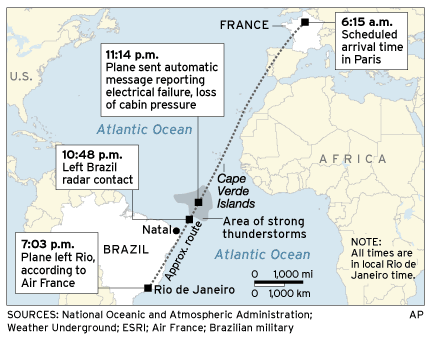
- What Happened to Flight 447?
June 1, 2009
http://www.reuters.com/article/2009/06/02/us-airline-crash
- A succession of a dozen technical
messages showed that several electrical systems had broken
down, most ominously the pressurization system - a totally
unprecedented situation in the plane. A succession of a
dozen technical messages (showed that) several electrical
systems had broken down.
- What Really Happened Aboard Air France
447
December 6, 2011
http://www.popularmechanics.com/technology/aviation/crashes/
- At 1h51m, the cockpit becomes
illuminated by a strange electrical phenomenon. The two
copilots discuss the unusually elevated external
temperature, which has prevented them from climbing to
their desired altitude. Suddenly, a strange aroma, like an
electrical transformer, floods the cockpit, and the
temperature suddenly increases. Just then an alarm sounds
for 2.2 seconds, indicating that the autopilot is
disconnecting. Note, however, that the plane has suffered
no mechanical malfunction. The word "Stall!" will blare
through the cockpit 75 times.
The Germanwings crash cannot blame the weather, which was
perfect. Per the Zetas, the airline industries will not allow
the truth to be told. Profits come first, and the lives of the
common man are the least of their concerns.
ZetaTalk Comment
3/28/2015: The
public will never learn the truth, as in all such cases
electromagnetic interference is dismissed, the profits and
jobs involved in the airline industry taking precedence of the
truth. This will result in any case as the public gets leery
of air travel, insurance costs rise, and airline companies go
out of business.
|

